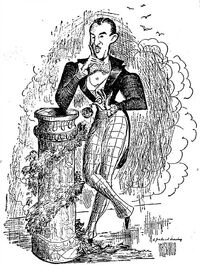Snow White and the Seven Dwarfs was America's first feature-length animated film, as well as the first in the Disney Animated Canon. It was also the first one in English, and the first in Technicolor. It was produced by Walt Disney Pictures and Walt Disney Productions, premiered on December 21, 1937, and was originally released to theaters by RKO Radio Pictures on February 8, 1938. The film is an adaptation of the Brothers Grimm fairy tale, in which an evil queen attempts to have her stepdaughter Snow White murdered in jealousy of her beauty, but the girl escapes and is given shelter by seven dwarfs in their cottage in a forest.
It is generally considered to be Walt Disney's most significant achievement, his first-ever animated feature. Snow White was the first major animated feature made in the United States, the most successful motion picture released in 1938, and, adjusted for inflation, is the tenth highest-grossing film of all time. This historical moment in motion picture history changed the medium of animation. Before 1937, short cartoons took up the majority of American animation.
The movie was adapted by Dorothy Ann Blank, Richard Creedon, Merrill De Maris, Otto Englander, Earl Hurd, Dick Rickard, Ted Sears and Webb Smith and was supervised by David Hand, and directed by William Cottrell, Wilfred Jackson, Larry Morey, Perce Pearce, and Ben Sharpsteen. Snow White is particularly memorable for songs like "Heigh-Ho" and "Some Day My Prince Will Come", several frightening and intense sequences, and a style influenced by European storybook illustrations.
Plot
Prologue
An ornately decorated book sets the scene: the Evil Queen, who cares only for being "the fairest one of all", is jealous of the beauty of her stepdaughter Snow White. She dresses the princess in rags and forces her to become a scullery maid in her castle. Each morning, she consults her Magic Mirror, asking the spirit within who is the fairest of all. The Mirror tells her that she is the fairest, and for a while, she is content.
The Wishing Well
One morning, the Mirror tells the Queen that there is a maiden fairer than she: Snow White. Meanwhile, Snow White is in the courtyard, singing "I'm Wishing" to herself as she works. The Prince, riding by the castle, hears her voice and is enchanted by it. He climbs over the castle wall, unseen by Snow White, who is singing to her reflection at the bottom of a well. The Prince joins in the singing, which startles and surprises Snow White; she runs indoors, but when he pleads for her to return she comes to the balcony and listens as he sings "One Song" to her. Unseen by both, the Queen watches from her window high above. Infuriated at Snow White's beauty (and perhaps jealous for the Prince's affections), she closes the curtains in anger. The Prince smiles at Snow White before leaving.
The Flight through the Forest
The Queen summons the Huntsman, whom she orders to take Snow White far into the forest, and kill her; she demands the girl's heart as proof. The Huntsman is reluctant to do so, but is bound by his orders; he takes Snow White deep into the forest, where he lets her gather flowers. As Snow White helps a baby bird find its parents, the Huntsman unsheathes his dagger and advances on the princess. When Snow White sees him approaching, she screams; however, he is unable to fulfill his orders and drops his dagger. Taking pity on Snow White, he begs for her forgiveness and, warning her of her stepmother's intentions, pleads for her to run away. As Snow White flees through the forest, her fear manifests itself in what she sees around her; eventually, she falls to the ground in fright. She is befriended by the animals of the forest; she sings "With a Smile and a Song" and asks them if they know of a place where she can stay.
The Cottage of the Seven Dwarfs
The animals lead her to the Cottage of the Seven Dwarfs, which she finds empty and dirty. Thinking that cleaning the house may persuade the owners to let her stay, Snow White and the animals clean the cottage and its contents while singing "Whistle While You Work". The seven dwarfs, meanwhile, are working in their mine, digging for diamonds. When it is time for them to go home for the day, they march through the forest, singing "Heigh-Ho".
After cleaning the house, Snow White falls asleep on several of the dwarfs' beds. When the dwarfs see light coming from the cottage, they approach cautiously, thinking that a monster has taken up residence in their home. They search the ground floor of the house but are afraid to go upstairs. After an unsuccessful attempt by Dopey to chase the 'monster' down, all seven dwarfs venture upstairs to discover Snow White sleeping. She wakes up and befriends each one of them. They allow her to stay (though Grumpy is reluctant). Snow White remembers that she has left soup downstairs and rushes to prepare it, ordering the dwarfs to wash while they wait. The dwarfs proceed outside to a trough, where all but Grumpy wash themselves; the six other dwarfs later wash Grumpy, dumping him into the trough when supper is ready.
The Heart of a Pig
That evening, the Queen once again consults her Magic Mirror, who tells her that Snow White still lives and that the Huntsman had given her a pig's heart. Furious at being tricked and the Huntsman's betrayal, the Queen descends a spiral staircase, entering her dungeon, where she resolves to do away with the princess herself. She uses a potion to transform herself into a witch-like peddler - a disguise to deceive Snow White. She then decides to use a Poisoned Apple to send Snow White into the Sleeping Death (a magically-induced coma). At the cottage, the dwarfs perform "The Silly Song", with Snow White singing and dancing along with them. She then sings "Some Day My Prince Will Come" (referring to her romance with the Prince) before sending them up to bed; however, the dwarfs decide to sleep downstairs, allowing Snow White to sleep in their beds, where she, looking towards the window, says thankful prayers about her and the dwarfs' protection, and wishes for Grumpy to like her more. Meanwhile, the Queen prepares the poisoned apple and, dismissing the possibility that Snow White may be revived by 'love's first kiss' (the only cure for the Sleeping Death), gleefully proclaims that Snow White will appear dead and be 'buried alive'. She leaves the castle and makes her way to the dwarfs' cottage, kicking the skeleton of a long-deceased prisoner on the way out.
The Poisoned Apple
As the dwarfs leave to the mine in the morning, Snow White kisses each dwarf on the forehead, though Grumpy initially resists. He warns her not to let any strangers into the house. After the dwarfs have left the cottage, the Queen in disguise goes to Snow White and offers her the poisoned apple, which Snow White is about to accept until the forest animals, sensing danger from the vultures, try to attack her. This causes Snow White to take pity on the old woman and takes her into the cottage. The animals then rush to the mine and try to tell the dwarfs of the danger. The dwarfs eventually realize what is happening, thanks to Sleepy, and, led by Grumpy, hurry back to the cottage with the animals. The Queen persuades Snow White to take a bite from the apple by telling her that it is a 'wishing apple', which will make any wish of hers come true; after biting the fruit, the princess falls into the Sleeping Death, as the Queen cackles in triumph. The dwarfs arrive and chase the Queen, eventually cornering her up a cliff, where she attempts to crush them with a boulder, but is sent over the cliff by a bolt of lightning, crushed by the boulder herself, and eventually devoured (off-screen) by the vultures that were following her.
Snow White is Revived
The dwarfs and animals mourn a seemingly dead Snow White, and place her into a glass coffin in a peaceful glade in the forest. The Prince arrives and, after singing a reprise of One Song, kisses Snow White, which breaks the spell. Awakened, she bids farewell to the dwarfs and animals, and rides into the sunset with the Prince to live happily ever after.
Cast
| Actor | Role(s) |
|---|---|
| Adriana Caselotti | Snow White |
| Lucille La Verne | The Evil Queen The Witch |
| Harry Stockwell | The Prince |
| Roy Atwell | Doc |
| Pinto Colvig | Grumpy Sleepy Dopey (hiccups) |
| Otis Harlan | Happy |
| Scotty Mattraw | Bashful |
| Billy Gilbert | Sneezy |
| Eddie Collins | Dopey |
| Stuart Buchanan | The Huntsman |
| Moroni Olsen | Magic Mirror |
| Marion Darlington Purv Pullen |
Birds |
Non-speaking roles are the Forest Animals, the Raven and the Vultures.
Sterling Holloway recorded dialogue for Sleepy in several test shots before being replaced with Pinto Colvig. Jimmy MacDonald provided additional voiceover work, including the yodeling heard in "The Silly Song".
Beginnings
Title card for Snow White and the Seven Dwarfs.
Walt Disney had been contemplating on making a feature-film since the early 1930s, considering ideas such as Babes in Toyland (Disney was unable to do this because it was earmarked for Laurel and Hardy by RKO), Rip Van Winkle, and an animation/live-action adaptation of Alice in Wonderland. It is thought that Walt Disney first felt that an audience could sit through a feature-length cartoon when he and Roy Disney went to receive an award from the League of Nations (for the creation of Mickey Mouse) in Paris in 1935, where a theatre featured a program of six consecutive Disney shorts. Disney later wrote that Snow White and the Seven Dwarfs was an inevitable and necessary step forward in order to advance the studio; short subjects, even successful ones like Three Little Pigs, still could not provide the studio with a significant profit. Disney may also have realized the potential of an animated feature after the success of Three Little Pigs.
It is thought that Disney was influenced in his decision by his favorite comic actors, including Laurel & Hardy and Charlie Chaplin, who had already moved from short subjects to features for similar reasons.
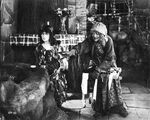 The 1916 silent film version. I saw the handwriting on the wall. My costs kept going up and up, but the short subject was just filler on any program. And so I felt I had to diversify my business. You could only get so much out of a short subject…I don't know why I picked "Snow White." The story is something I remembered as a kid. I once saw Marguerite Clark performing in it in Kansas City when I was a newsboy back in 1917. It was one of the first big pictures I'd ever seen. That was back in 1917…I thought it was the perfect story. It had the sympathetic dwarfs, you see? It had the heavy. It had the prince and the girl. The romance, I just thought it was a perfect story. |
Disney revealed, in a magazine article for Photoplay Studies, that, as a boy, he had saved some of the money from his newspaper round to see a play of Snow White. In fact, Disney was referring not to a play but a film, starring Marguerite Clark, which he saw in a free showing in the theatre Kansas City Convention Centre in 1916; Disney was sitting in one of the top galleries of the theatre. It is unknown whether the film was available for reference during the production of Disney's feature. Disney first revealed his plans for Snow White to his key animators after dinner one evening in 1934, when he gave each of his key animators fifty cents, took them out to dinner, after which he took them to the studio's sound stage, where he told them the entire story, acting out every part.
Despite being impressed with Disney's idea, the animators were still nervous that an animated feature would not sustain an audience's full attention. Many in Hollywood were even more skeptical, christening the project 'Disney's Folly'. Even Roy O. Disney and Lillian Disney attempted to discourage Walt from continuing the film. In 1934 Disney estimated the film's budget at $250,000; he was forced to mortgage his house when this eventually ballooned into an impressive $1.5 million. An article of 3 June 1934 reported (presumably jokingly) that, "If, after it is made, he thinks it will disappoint the public, he will destroy it." Existing evidence suggests that serious preliminary work on the film did not begin until 9 August 1934. That same year, it appears Disney had planned to have the film completed by early 1936.
Production
Story Development
Early Ideas
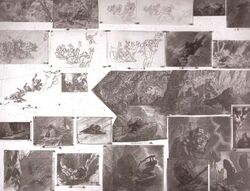
Storyboards for the chase of the Witch.
On 9 August 1934, twenty-one pages of notes - entitled "Snow White suggestions" - were compiled by staff writer Richard Creedon who suggested the principal characters, as well as situations and 'gags' for the story. As Disney had stated at the very beginning of the project, the main attraction of the story for him was the Seven Dwarfs, and their possibilities for 'screwiness' and 'gags'; the three story meetings held in October and attended by Disney, Creedon, Larry Morey, Albert Hurter, Ted Sears and Pinto Colvig were dominated by such subjects. At this point, Disney felt the story should begin with Snow White's discovery of the Cottage of the Seven Dwarfs. Walt had suggested from the very beginning that each of the dwarfs, whose names are not stated in the original story, could all have individual personalities. The dwarfs names were chosen from a pool of about fifty potentials, including Jumpy, Deafy, Dizzey, Hickey, Wheezy, Baldy, Gabby, Nifty, Sniffy, Swift, Lazy, Puffy, Stuffy, Tubby, Shorty, Burpy, and even Awful. The seven finalists were chosen through a process of elimination. The leader of the dwarfs, required to be pompous, self-important and bumbling, was named Doc; others were named for their distinguishing character traits. At the end of the October story meetings, however, only Doc, Grumpy, Bashful, Sleepy and Happy of the final seven were named; at this point, Sneezy and Dopey were replaced by 'Jumpy' and an unnamed seventh dwarf.

Early designs for the film's human cast.
Along with a focus on the characterizations and comedic possibilities of the dwarfs, Creedon's 18-page outline of the story written from the October meetings, featured a continuous flow of gags as well as the Queen's attempt to kill Snow White with a poisoned comb, taken from the Grimms' fairy tale. After persuading Snow White to use the comb, the disguised Queen would have escaped alive, but the dwarfs would have arrived in time to remove it. After the failure of the comb, the Queen was to have the Prince captured and taken to her dungeon, where she would have come to him (story sketches show this event both with the Queen and the Witch) and used magic to bring the dungeon's skeletons to life, making them dance for him and identifying one skeleton as 'Prince Oswald' (an example of the more humorous atmosphere of this story treatment). It is written in story notes that the Queen has such magical power only in her own domain, the castle. With the Prince refusing to marry her, the Queen leaves him to his death (one sketch shows the Prince trapped in a subterranean chamber filling with water) as she makes her way to the dwarfs' cottage with the poisoned apple. The forest animals were to help the Prince escape the Queen's minions and find his horse. The Prince would then ride to the cottage to save Snow White, but took the wrong road (despite warnings from the forest animals and his horse, which he, unlike Snow White, could not understand). He, therefore, would not have arrived in time to save her from the Queen. This plot would not be used in the final film, though many sketches of the scene in the dungeon were made by Ferdinand Hovarth. Other examples of the more comical nature of the story at this point include suggestions for gags with the Witch's warts and a "fat, batty, cartoon type, self-satisfied" Queen. The Prince was also more of a clown, and was to serenade Snow White in a more comical fashion. Walt Disney encouraged all staff at the studio to contribute to the story, offering five dollars for every 'gag'; such gags included the dwarfs' noses popping over the foot of the bed when they first meet Snow White.
Reworking

A sketch by Ferdinand Hovarth of the Witch imprisoning the Prince in a torture device.
However, Disney was concerned that such a comical approach would lessen the plausibility of the characters and, sensing that more time was needed for the development of the Queen, advised in an outline circulated on 6 November that attention be paid exclusively to "scenes in which only Snow White, the Dwarfs, and their bird and animal friends appear." The names and personalities of the dwarfs, however, were still "open to change." A meeting of 16 November resulted in another outline entitled "Dwarfs Discover Snow White", which introduced the character of Dopey, who would ultimately prove to be the most successful and popular of the dwarfs. For the rest of 1934 Disney further developed the story by himself, finding a dilemma in the characterization of the Queen, who he felt could no longer be "fat" and "batty", but a "stately beautiful type" (a possibility already brought up in previous story meetings). Disney did not focus on the project again until the autumn of 1935; it is thought that he may have doubted his studios ability, and that his trip to Europe that summer had restored his confidence. At this point, Disney and his writers focused on the scenes in which Snow White and the dwarfs are introduced to the audience and each other. He laid out the likely assignments for everyone working on the film in a memorandum of 25 November 1935 and had decided on the personalities of the individual dwarfs.

Originally, the meeting between Snow White and the Prince was to be more comical in nature.
Though it had first been thought that the dwarfs would be the main focus of the story, and many sequences were written for the seven characters; at a certain point, it was decided that the main thrust of the story should be provided by the relationship between the Queen and Snow White. For this reason, several sequences featuring the dwarfs were cut from the film. The first, which was animated in its entirety before being cut, showed Doc and Grumpy arguing about whether Snow White should stay with them. Another, also completely animated, would have shown the dwarfs eating soup noisily and messily; Snow White (unsuccessfully) attempts to teach them how to eat 'like gentlemen'. A partially animated sequence involved the dwarfs holding a 'lodge meeting' in which they try to think of a gift for Snow White; this was to be followed by the elaborate 'bed building sequence', in which the dwarfs and the forest animals construct and carve a bed for the princess, but was cut, as it was thought to slow down the movement of the story. The soup-eating and bed-building sequences were animated by Ward Kimball, who was sufficiently discouraged by their removal to consider leaving the studio, though he ultimately decided to remain.
Design
Inspirational Sketch Artists
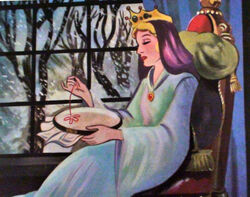
Queen Eva, Snow White's mother and deleted character in movie.
The primary authority on the design of the film was inspirational sketch artist Albert Hurter. All designs used in the film, from character's appearances to the look of the rocks in the background, had to meet Hurter's approval before being finalized. Two other inspirational sketch artists contributed to the visual style of Snow White: Ferdinand Hovarth (whose designs were often thought not to be as easily translated into animation as Hurter's, but who produced a number of dark concepts for the film) and Gustaf Tenggren, whose style borrowed from the likes of Arthur Rackham and John Bauer and thus possessed the European illustration quality that Walt Disney was interested in. Tenggren was used primarily as a color stylist and to determine the staging and atmosphere of many of the scenes in the film. He also designed the poster for the film and illustrated the press book. However, only Hurter receives a credit for the film, as a character designer. Other artists to work on the film included Joe Grant, whose most significant contribution was the design for the Evil Queen's Witch form.
Design and Animation of Human Characters
| Don Graham really knew what he was teaching, and he "showed" you how to do something – he didn't just talk. He taught us things that were very important for animation. How to simplify our drawings – how to cut out all the unnecessary hen scratching amateurs have a habit of using. He showed us how to make a drawing look solid. He taught us about tension points – like a bent knee, and how the pant leg comes down from that knee and how important the wrinkles from it are to describe form. I learned a hell of a lot from him! —Art Babbit[1] |
Art Babbit, an animator who joined the Disney studio in 1932 invited seven of his colleagues (who all worked in the same room as him) to an art class that he himself had set up at his home in the Hollywood Hills. Though there was no teacher, Babbit had recruited a model to pose for him and his fellow animators as they drew. These 'classes' were held weekly; each week, more animators would come. After three weeks, Walt Disney called Babbit to his office and offered to provide the supplies, working space and models required if the sessions were moved to the studio. Babbit ran the sessions for a month until animator Hardie Gramatky suggested that they recruit Don Graham the art teacher from the Chouinard Institute taught his first class at the studio on 15 November 1932, and was joined by Phil Dike a few weeks later. These classes were principally concerned with human anatomy and movement, though instruction later included action analysis, animal anatomy and acting.
| The first duty of the cartoon is not to picture or duplicate real action or things as they actually happen, but to give a character life and action; to picture on the screen things that have run through the imagination of the audience and to bring to life dream-fantasies and imaginative fancies that we have all thought of during our lives or have had pictured to us in various forms during our lives… I definitely feel that we cannot do the fantastic things based on the real unless we first know the real. This point should be brought out very clearly to all new men, and even the older men. —Walt Disney in 1935[2] |
Though the classes were originally described as a "brutal battle", with neither instructor nor students well learned in the other's craft, the enthusiasm and energy of both parties made the classes stimulating and beneficial for all involved. Graham would often screen Disney shorts and, along with the animators, pick out both strengths and weaknesses. For example, Graham criticized Babbit's animation of Abner the mouse in The Country Cousin as "taking a few of the obvious actions of a drunk without coordinating the rest of the body", while praising it for maintaining its humor without getting "dirty or mean or vulgar. The country mouse is always having a good time."
Very few of the animators at the Disney studio had had artistic training (most had been newspaper cartoonists); among these few was Grim Natwick who had trained in Europe. The animator's success in designing and animating Betty Boop for the Fleischer cartoons showed an understanding of human female anatomy, and when Walt Disney hired Natwick he was given female characters to animate almost exclusively. Attempts to animate Persephone, the female lead of The Goddess of Spring, had proved largely unsuccessful; Natwick's animation of the heroine in Cookie Carnival showed greater promise and was eventually given the task of animating Snow White herself. Though live action footage of Snow White, the Prince and the Queen was shot as reference for the animators, many of them disapproved of rotoscoping, considering it to hinder the production of effective caricature. None of Babbit's animation of the Queen was rotoscoped; despite Graham and Natwick's objections. However, some scenes of Snow White and the Prince were directly traced from the live-action footage.
The Disney Studio Library
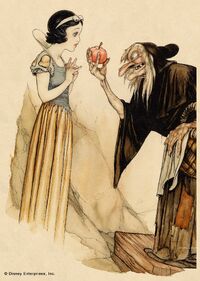
Artists such as Gustaf Tenggren introduced the influence of European illustrators.
In the spring and early summer of 1935, Walt Disney, along with Roy O. Disney, their wives Lillian and Edna, and draftsman Bill Cottrell, spent eleven weeks in Europe, vacationing in England, France, Italy, Holland and Switzerland. The trip was intended as a relaxing holiday, and for Disney to receive a special medal from the League of Nations; on the way, however, Disney bought nearly three hundred and fifty books; illustrators included, among others, Arthur Rackham, Gustave Dore, Honore Daumier, Grandville, Benjamin Rabier, Ludwig Richter, Wilhelm Busch, Heinrich Kley Attilio Mussino, Sir John Tenniel and Charles Folkard (many of these illustrators had been recommended by Hurter and Joe Grant). Disney added all these books to the studio library, and a further 90 from France, 81 from England, 149 from Germany and 15 from Italy, were added to the library in July of the same year.
The Disney artists and animators frequently borrowed and referred to the books of the studio library, which could frequently be seen on drawing boards. Rackham's influence on the style of the film is perhaps the most obvious; his illustrations of gnarled trees coming to life inspired the faces Snow White sees in her flight through the forest, his depictions of dwarfs, gnomes and goblins played a part in the design of the seven dwarfs, and similarities have been noted between Joe Grant's design for the Witch and the old woman in Rackham's illustration for "Hansel and Gretel". However, the other illustrations influenced various different elements of the film. Dore's etchings for Dante's Divine Comedy, in particular, inspired the caverns below the Queen's castle, as did Piranesi's "Carceri" series. It is rumored that Disney intended to recruit Rackham for visual development of Snow White and the Seven Dwarfs, but that the illustrator was too frail to move to America.
Cinematic Influences
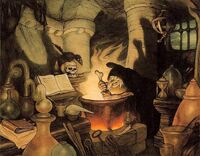
An inspirational sketch by Gustaf Tenggren demonstrates the expressionistic use of shadows in the film.
At this time, Disney also encouraged his staff to see a variety of films. These ranged from the mainstream, such as MGM's Romeo and Juliet (to which Disney made direct reference in a story meeting pertaining to the scene in which Snow White lies in her glass coffin), to the more obscure, including European silent films. The influence of German expressionism (examples of which exist in Nosferatu and The Cabinet of Dr. Calligari both of which were recommended by Disney to his staff) can be found in Snow White (as well as their future films), particularly in the scenes of Snow White fleeing through the forest and the Queen's transformation into the Witch. The latter was also inspired by 1931's Dr. Jekyll and Mr. Hyde, to which Disney made specific reference in story meetings.
Reception and success
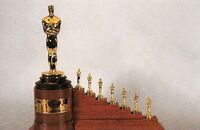
The award presented to Walt Disney. Contains 7 Dwarves with it.
Snow White and the Seven Dwarfs premiered at the Carthay Circle Theater on December 21, 1937 to a widely receptive audience (many of whom were the same naysayers that dubbed the film "Disney's Folly"), who gave the film a standing ovation at its completion. Animator Ward Kimball recalled many people (including many celebrities) crying towards the end of the film. RKO Radio Pictures put the film into general release on February 4 1938, and it went on to become a major box-office success, making more money than any other motion picture at that time. It is estimated that more people saw the film on its general release than Star Wars. In fact, for a short time, Snow White was the highest grossing film in American cinema history; it was removed from that spot by Gone With the Wind in 1940. A subject of particular criticism was the film's depiction of Snow White, the Queen and the Prince as realistic human figures, which caused some (including successful New York caricaturist Al Hirschfeld) to believe that Disney was too closely following live-action and realism, thus rejecting the qualities that made cartoons such as the Silly Symphonies unique.
Certain scenes in Snow White and the Seven Dwarfs, particularly those featuring the Witch, are regarded as some of Disney's most frightening moments. British censors considered the film frightening enough for young viewers to be accompanied by an adult. Animators Frank Thomas and Ollie Johnston, felt that Walt Disney restrained his animators from creating such a terrifying villain again. Later films such as Pinocchio, Fantasia and Bambi would receive similar accusations for their frightening and intense sequences.
For his achievement in Snow White and the Seven Dwarfs, Walt Disney received a full-size Oscar statuette alongside seven miniature ones, presented to him by Shirley Temple; the film was deemed "as a significant screen innovation which has charmed millions and pioneered a great new entertainment field." The movie was also nominated for Best Music, Score. Review aggregator website Rotten Tomatoes reports that 98% of the critics gave the film a positive review based on 41 reviews. It's consensus states, "With its involving story and characters, vibrant art, and memorable songs, Snow White and the Seven Dwarfs set the animation standard for decades to come."
Re-release schedule and home video
- Main article: Snow White and the Seven Dwarfs (video)
Snow White and the Seven Dwarfs was first re-released in 1944, in order to raise revenue for the Disney studio during World War II This eventually set a tradition of re-releasing Disney animated films every seven years. Snow White was re-released to theaters in 1952, 1958, 1967, 1975, 1983, 1987 and 1993. The film was restored for its 1987 fiftieth-anniversary re-release, and a more comprehensive digital restoration was done for the 1993 re-release.
Snow White was first released on home video in 1994, and was released on Disney DVD in 2001. The Snow White DVD was the first in Disney's Platinum Edition line of releases, and featured, across two discs, the digitally restored film, a making-of documentary, an audio commentary by John Canemaker and (via archived audio clips) Walt Disney, and many more special features. The DVD went to the Disney Vault in January 2002.
Walt Disney Studios Home Entertainment has confirmed that Snow White and the Seven Dwarfs was released on Blu-ray disc on October 6, 2009 and on a new DVD edition on November 24, 2009. This version had a new restoration by Lowry Digital and had the original 1937 titles restored, especially the RKO Radio Pictures logo. The Blu-ray went into the Disney Vault on April 30, 2011.
Snow White and the Seven Dwarfs was released on Digital HD on January 19, 2016 and on Blu-ray and DVD on February 2, 2016 as a part of the Walt Disney Signature Collection.
Videos
Signature Edition Videos
Trivia
A poster for "Snow White: Live at Radio City Music Hall".
There have been numerous ideas as to the presence of occult significance or symbolism within the movie, mostly centered around the Dwarves themselves. For example, one theory holds that the seven dwarves correspond to the seven chakras (or cakras), and that Snow White represents consciousness moving through them. Other ideas are less philosophically complex, such as correspondences to the stages inherent in the use of certain drugs. In one theory, Snow White is cocaine, which causes exhaustion (Sleepy), mood swings (Happy, Grumpy), allergies (Sneezy) and alteration of personality (Bashful, Dopey) eventually resulting in a trip to the doctor (Doc). More on this
- The movie's title uses the word "dwarfs" which was the traditional plural of "dwarf". The Lord of the Rings by John Ronald Reuel Tolkien, published in three volumes from 29 July, 1954 to 20 October, 1955, instead popularized the spelling "dwarves". Both plural forms have been used interchangeably since then.
- There are only two times the word(s) dwarf(s) has been used. Once by the Magic Mirror, "Over the seven jeweled hills, beyond the seventh fall, in the cottage of the Seven Dwarfs, dwells Snow White, fairest one of all." And again by the Queen in disguise after finding an antidote for the poisoned apple, "No fear of that! The dwarfs will think she's dead! She'll be buried alive!"
- A version with live actors based on the film, made in 2002, was titled Snow White: The Fairest of Them All and starred Kristin Kreuk.
- Upon seeing the film, Russian director Sergei Eisenstein called it the greatest ever made.
- The song "Some Day My Prince Will Come" became a jazz standard, and has been performed by numerous artists, including Buddy Rich, Oscar Peterson and Miles Davis.
- The movie was chosen by the American Film Institute as the number one animated film of all time.
- In 1979 the film inspired a stage musical. It premiered at Radio City Musical Hall and starred Broadway stage veteran Anne Francine as The Queen and then-unknown Mary Jo Salerno as Snow White. It was directed and staged by Frank Wagner, as well as produced by Robert Jani, and it is known for saving Radio City Musical Hall from closing down. In 1980, it was taped and broadcast on HBO as "Snow White Live".
- Snow White and the Seven Dwarfs is one of the few classic Disney movies to not have a sequel.
- The Seven Dwarfs have only four fingers; one thumb, and three other digits.
- Snow White and the Seven Dwarfs was Disney's first animated feature, as well as the first Disney feature overall, to be preserved in the National Film Registry of the Library of Congress. Four other Disney films would later achieve this honor and be preserved in the following future years: Fantasia in 1990, Pinocchio in 1994, Beauty and the Beast in 2002 and Bambi in 2011.
- The 1993 theatrical and VHS releases have restoration credits and the 1990 Walt Disney Pictures logo at the end. The Blu-ray release has the RKO and Disney logos instead.
- At the end of the movie, Snow White only kisses six dwarfs goodbye before leaving with the Prince; the one dwarf she left out was Sleepy.
- In March 2016, Disney announced a new film in development titled, Rose Red; a live-action spin-off film which will be told from the point-of-view of Snow White's sister.
- In 2016 Walt Disney Signature Collection was released, with Snow White and the Seven Dwarfs being the first film in that collection.
- This is the third Disney animated classic to have the 2006 Walt Disney Pictures logo at the end of the movie, on current releases.
Allusions
- At one point, the dwarfs say "Jiminy Crickets", to express their surprise on seeing their house occupied. Since Pinocchio, the phrase has become more synonymous with a voice of reason or conscience.
In Disney Parks
The attraction Snow White's Scary Adventures appears in four of the five Disney resorts around the world. Much of the cast also appear as walk-around characters, including Snow White, the Dwarfs, the Prince, and the Queen. Other appearances in the parks include:
- Snow White's Grotto, a small area near Fantasyland at Disneyland, Hong Kong Disneyland and Tokyo Disneyland.
- The Candy Cauldron, a candy shop specializing in Caramel Apples at Downtown Disney themed to the Queen and Witch.
- Storybook Land Canal Boats feature the cottage and mine of the Seven Dwarfs.
- Mickey Mouse Revue, an attraction that formerly appeared at Magic Kingdom and Tokyo Disneyland, featuring Snow White and the Dwarfs.
- Cinderella Castle Mystery Tour, a former Tokyo attraction focusing on the villains that featured the Witch's Laboratory.
- Seven Dwarfs Mine Train, a roller coaster constructed as part of the Fantasyland expansion at the Magic Kingdom, and part of the opening at Shanghai Disneyland.
- Fantasmic! features Snow White and the Prince in its Princess medley, and the Queen serves as the primary antagonist. In its Tokyo DisneySea incarnation, the Magic Mirror plays a larger role in the show, serving as a means of trapping Mickey and a projection surface for the Disney Villains to appear inside, folding back for the climactic encounter with Dragon Maleficent.
Differences from the Source Material
- Snow White's birth mother and father appear at the beginning of the story.
- Snow White is only seven years old when she is declared "the fairest one of all" and the Queen sends the huntsman to kill her. Being a family film, Disney increased her age to 14 to soften the story.
- The Queen was actually more malice than in the film. In the original story, after the huntsman brings back the heart, liver, and lungs of a boar, the Queen, thinking they are Snow White's own organs, has them made into a stew which she then eats, delighted in knowing that she's been killed.
- In the film, it was the Huntsman who told Snow White to run away upon witnessing her innocence and beauty. In the original story, Snow White pleaded him not to kill her, and promised that she would run away in the forest. Believing that she will die anyway, the Huntsman lets her go, and kills a wild boar instead.
- Snow White did not have any animal friends.
- The dwarfs were much more gruff to Snow White at first, but they grew to love her over time as they let her into their home.
- The Queen does not transform into a peddler woman, but merely paints her face.
- The Queen tried to kill Snow White three times. The first was by lacing her up so tightly that she couldn't breathe. After that fails, she tries to drug her with a poisoned comb. And when that fails, she finally uses a poisoned apple.
- In the story, Snow White sleeps in the glass coffin for many years, growing up into a young woman while in her death-like slumber, while in the film, she sleeps in the coffin for about one year.
- In the fairy tale, Snow White actually wasn't awakened by "love's first kiss". Instead, the prince buys the coffin from the dwarfs and they help him carry it back to his castle. But one of them trips, causing the coffin to fall, which dislodged the piece of the apple from her throat.
- At the very end of the story, the Queen attends the prince's wedding and is shocked to see that the bride is Snow White. As punishment for her deeds, her feet are forcibly placed into iron shoes that had been sitting on red hot coals, and dances until she dies. In the film, the Queen was defeated much earlier. After being chased by the dwarfs up a cliff, she soon falls to her death when lightning strikes the cliff ledge.
Gallery
References
- ↑ Bruno Girveau (editor), Once Upon a Time — Walt Disney: The Sources of inspiration for the Disney Studios (Prestel, London, 2006) ISBN 978-3-7913-3770-8
- ↑ Usher, Shaun (June 15, 2010). "Letters of note: How to Train an Animator, by Walt Disney".
External links
 Snow White and the Seven Dwarfs on Wikipedia
Snow White and the Seven Dwarfs on Wikipedia Snow White and the Seven Dwarfs on Disney.com
Snow White and the Seven Dwarfs on Disney.com- Filmic Light: A Snow White Sanctum
- Template:Imdb title
- Snow White on Lux Radio Theater: December 26, 1938. Guest appearance by Walt Disney.
- Snow White on Screen Guild Theater: December 23, 1946
| v - e - d | ||||||||||||||||
|---|---|---|---|---|---|---|---|---|---|---|---|---|---|---|---|---|
|

